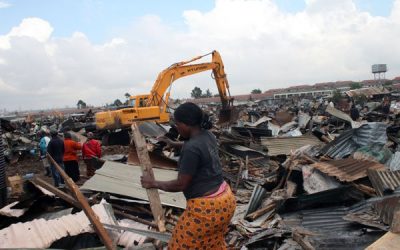According to the Kenya Vision 2030, infrastructure sector is one of the foundations of the pillars expected to provide cost effective world class facilities and services. To achieve this, several factors have to be put into consideration in order to start the process. Unfortunately, the public is not well aware of what needs to be met before the process of demolition of property near areas where roads are to be constructed.
Normally, evictions happen when people fail to pay rent or loans, or when they have illegitimately occupied land that is public or private or as a result of land ownership disputes. In this case, the most visible cases of forceful evictions happen when the government reclaims land for public use like road construction.
Eviction has been a common problem not just in Nairobi but in other counties as well. Kibera mass eviction, the most recent is still new in the minds of Kenyans as it was all over the media late last month. The Ngong -Kibera-KunguKarumba-Lang’ata Link Road that has been under construction since 2016 was the reason for the demolition of the ‘illegal’ structures along the bypass. The residents with ‘illegal’ structures were given a 14day ultimatum to vacate by the National Building Inspectorate. It is interesting though that the slum locals had initially filed two cases, challenging the expected demolition of their homes and displacement, but the case was thrown away thus giving a leeway for the construction of the Ngong-Lang’ata road.
Another similar incident happened in Garissa where residents who dwelled near the town were given a two weeks’ notice to either vacate for construction of Ring Road, or face forceful evictions. Those with illegal structures were ordered to pull them down.
Back in 2015, residents living along the A 109 highway in Jomvu faced similar evictions. More than 100 inhabitants of informal settlements along the highway were victims of the evictions. In their case they received a 30day eviction notice by the Kenya National Highway Authority (KeNHA) to vacate and pave way for the road construction.
These are just a few examples of the long chain to bring out the pattern that has already been witnessed. It is interesting to note of the ‘short’ notices the affected residents receive; 14 to 30days. Isn’t that too short a period to ask people to pull down illegal infrastructure and vacate? What is the compensation plan? Is there even compensation to begin with? For Kibera the Kenya Urban Roads Authority (Kura) maintained there would be no compensation for the residents as the land belonged to government.
What measures should be taken to deal with such victims? Their properties were brought down by bulldozers, so even if they survived the process, their properties did not. Even if they are moving to start life elsewhere, are they going to start from scratch? At least for those who hold their lands under a title deed or under a lease are safe as they can contest there matters in court for compensation. What about the majority others who are forced out of their homes and denied their right to due legal process? Such evictions exact huge negative impacts on victim’s socio-economic welfare. They often lose their belongings and potential livelihoods without compensation, and don’t have any other place to live.
The government should come up with better methods (if there exists none at the moment), that contain clear structure of what happens to victims of such situations. The following are some recommendations that could be considered, lifted from the environmental and social handbook;
- Appropriate notice to all potentially affected persons that eviction is being considered and that there will be public hearings on the proposed plans and alternatives;
- Effective dissemination by the authorities of relevant information in advance, including land records and proposed comprehensive resettlement plans specifically addressing efforts to protect vulnerable groups;
- A reasonable time period for public review of, comment on, and/or objection to the proposed plan;
- Opportunities and efforts to facilitate the provision of legal, technical and other advice to affected persons about their rights and options;
- Holding of public hearing(s) that provide(s) affected persons and their advocates with opportunities to challenge the eviction decision and/or to present alternative proposals and to articulate their demands and development priorities.

